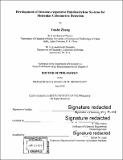| dc.contributor.advisor | T. Alan Hatton. | en_US |
| dc.contributor.author | Zhang, Yunfei, Ph. D. Massachusetts Institute of Technology | en_US |
| dc.contributor.other | Massachusetts Institute of Technology. Department of Chemistry. | en_US |
| dc.date.accessioned | 2018-09-28T21:00:14Z | |
| dc.date.available | 2018-09-28T21:00:14Z | |
| dc.date.copyright | 2018 | en_US |
| dc.date.issued | 2018 | en_US |
| dc.identifier.uri | http://hdl.handle.net/1721.1/118284 | |
| dc.description | Thesis: Ph. D., Massachusetts Institute of Technology, Department of Chemistry, 2018. | en_US |
| dc.description | Cataloged from PDF version of thesis. | en_US |
| dc.description | Includes bibliographical references (pages 110-116). | en_US |
| dc.description.abstract | Direct and convenient detection of hazardous molecules in the environment, agriculture, and industry plays a critical role in humanity's health and safety. In order to achieve this goal, I have rationally designed polydiacetylene systems that possess unique optical properties such as color changing in the presence of external stimulus. These advanced polydiacetylene systems are conjugated with functional groups having specific targeting ability toward targeted hazardous molecules to build up a stimulus-responsive structure for molecular colorimetric detections. In the first part of the work, pyridine-2-aldoxime, capable of binding pesticide malathion, was conjugated with diacetylene monomer, followed by the conjugate polymerization under UV irradiation to form a stimulus-responsive system. The rapid, specific and sensitive colorimetric detection of malathion was demonstrated both in aqueous suspension and on solid support. Within seconds, the successful detection of malathion through color changes observed by the naked eye was accomplished, with a detection limit of mmol/L for liquid suspensions and nmol/cm 2 for solid membranes. Furthermore, density functional theory (DFT) calculations on this system before and after binding to malathion unveiled the mechanism of spectral change as the detection progressed. The second part of the work describes the conjugation of dipicolylamine to diacetylene and the polymerization of as-conjugated diacetylene. This polydiacetylene-dipicolylamine system has visible colorimetric response to lanthanide ions exposure within one minute, and this response is highly selective toward lanthanide ions evidenced by the absence of colorimetric response to the control metal ion Hg²⁺. Remarkably, through the color change observation by naked eye, the lanthanide ions (Gd³⁺ Ce³⁺ Er³⁺) detection limit was shown to be as low as [mu]mol/L in aqueous suspensions and nmol/cm2 on solid supports. In summary, two polydiacetylene systems were developed and demonstrated to be rapid, sensitive and selective sensors for the colorimetric detection of their target molecules. The mechanism of the colorimetric response elucidated by DFT calculations, which is beneficial for future molecular sensor design. These research results not only develop the efficient sensor systems for the detection of pesticide and lanthanide ions but also be valuable for the design of more advanced polydiacetylene sensors of varying target molecules in the future. | en_US |
| dc.description.statementofresponsibility | by Yunfei Zhang. | en_US |
| dc.format.extent | 116 pages | en_US |
| dc.language.iso | eng | en_US |
| dc.publisher | Massachusetts Institute of Technology | en_US |
| dc.rights | MIT theses are protected by copyright. They may be viewed, downloaded, or printed from this source but further reproduction or distribution in any format is prohibited without written permission. | en_US |
| dc.rights.uri | http://dspace.mit.edu/handle/1721.1/7582 | en_US |
| dc.subject | Chemistry. | en_US |
| dc.title | Development of stimulus-responsive polydiacetylene systems for molecular colorimetric detection | en_US |
| dc.type | Thesis | en_US |
| dc.description.degree | Ph. D. | en_US |
| dc.contributor.department | Massachusetts Institute of Technology. Department of Chemistry | |
| dc.identifier.oclc | 1054250551 | en_US |
